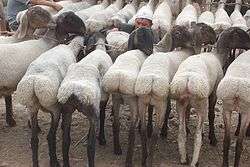Fat-tailed sheep

The fat-tailed sheep is a general type of domestic sheep known for their distinctive large tails and hindquarters. Fat-tailed sheep breeds comprise approximately 25% of the world sheep population,[1] and are commonly found in northern parts of Africa, the Middle East, Pakistan, Afghanistan, Iran, North India, Western China, Somalia[2]and Central Asia.[3]
The earliest record of this sheep variety is found in ancient Uruk (3000 BC) and Ur (2400 BC) on stone vessels and mosaics. Another early reference is found in the Bible (Leviticus 3:9), where a sacrificial offering is described which includes the tail fat of sheep.
Sheep were specifically bred for the unique quality of the fat stored in the tail area and the fat (called Elyah, Arabic:[4] ألية ) was used extensively in medieval Arab and Persian cookery. The tail fat is still used in modern cookery, though there has been a reported decline, with other types of fat and oils having increased in popularity.


Fat-tailed sheep are hardy and adaptable, able to withstand the tough challenges of desert life. When feed is plentiful and parasites not a major factor, fat-tailed sheep can be large in size and growth. The carcass quality of these sheep is quite good, with most of the fat concentrated in the tail area - it could account for as much as 10 pounds (4.5 kilograms) of the weight on a 60 pound (27 kilogram) carcass. The fat-tailed breeds seen frequently in the US are the Karakul and Tunis.
The wool from fat-tailed breeds is usually coarse and frequently has colored fibers. It would be of limited value in commercial markets. Today it is used primarily for rug-making and other cottage-type industries. Bedouin women make rugs and blankets from the wool. Some of their handiwork can be purchased in the villages of Egypt. Shearing in Egypt is done once or twice a year with hand clippers. There is a reluctance to use electric shears because of wool quality and the difficulty in getting replacement parts when they become dull or worn out.
The fat from fat-tailed sheep is called tail fat and is used in foods, candies, soaps.
Breeds
- Afrikaner
- Awassi
- Balkhi
- Blackhead Persian
- Chios
- Karakul
- Laticauda
- Pedi
- Red Maasai
- Tunis
- Van Rooy
- Zulu, or Nguni
References
- ↑ Davidson, Alan (1999). Oxford Companion to Food. Oxford: Oxford University Press. pp. 290–293. ISBN 0-19-211579-0.
- ↑ http://www.jstor.org/stable/3014215?seq=1#page_scan_tab_contents
- ↑ Reay Tannahill, 1973, Food in History p. 62 and 176. ISBN 0-8128-1437-1
- ↑ http://www.almaany.com/ar/dict/ar-en/ألية/